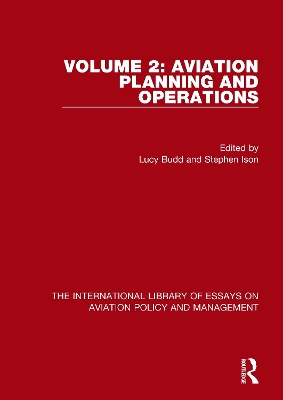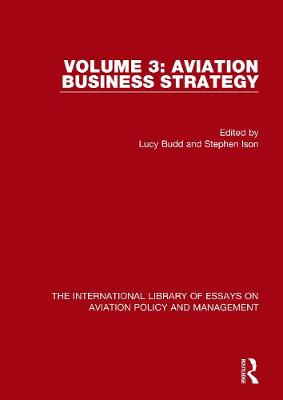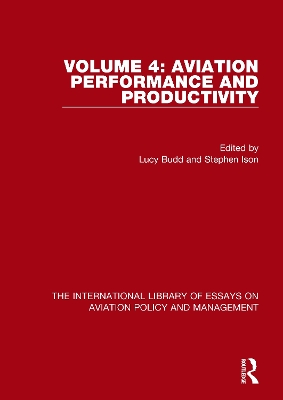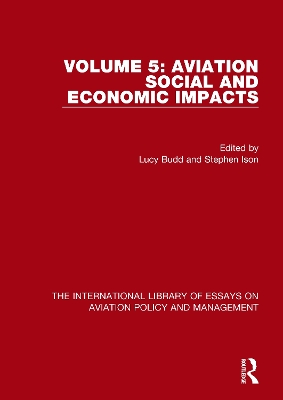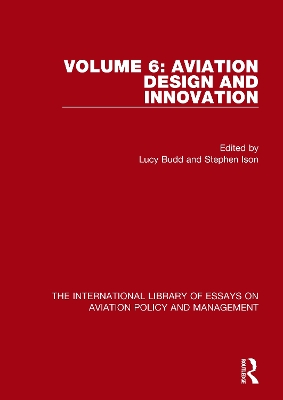The International Library of Essays on Aviation Policy and Management
5 primary works
Book 2
The delivery of reliable and efficient aviation services is predicated on effective decisions being made concerning the planning and provision of airport and aircraft infrastructure. Decisions that are made about investment and capacity provision have long term implications for airports, airlines and consumers. This Volume addresses issues of forecasting, infrastructure planning and provision, capacity, scheduling, safety and security, disruption management and resilience.
Accurately forecasting consumer demand for air travel is a vitally important but notoriously challenging aspect of aviation policy formation and management. Forecasts of airline and airport activity may differ considerably from original predictions and there have been many examples of operational difficulties resulting from the over or underestimation of demand. Such issues are apparent not only in terminal buildings but also on the airfield and are of critical interest to planners and operational decision makers. Another activity which is of paramount importance is scheduling. Scheduling forms a vital part of airline operations as it is concerned with making the optimum use of scare resources and meeting consumer demand profitably.
In terms of aviation planning and operations the importance of safety and security cannot be overstated and a number of essays in this Volume address this area. Together with safety and security concerns, a number of other factors have the potential to disrupt planned schedules and any disruption has the potential to cause delays, inconvenience and lost productivity and so ensuring a quick and orderly return to normal routine operations is vital.
Book 3
The world’s commercial aviation industry comprises a complex and highly diverse range of businesses with different forms of governance, ownership, management structure and organisational philosophies. The essays in this Volume address issues of market structure, focusing particularly on changes in the aviation industry that have resulted from policies of deregulation, as well as revenue, cost and pricing, airline mergers and acquisitions and the reasons for and characteristics of global airline alliances.
One of the most significant developments in aviation business strategy over the last four decades has been the emergence and expansion of low cost carriers and the implications that this business model has had for the sector in terms of competition, route offering, service innovation and profitability. Central to these discussions are issues of cost and the need to manage yields. This raises the issue of pricing, elasticity, and price discrimination, all of which are of relevance to passenger airlines, air cargo operators and airports.
Policies of air service deregulation and liberalisation have fundamentally changed the market structure of airlines and airports. As a result of new airlines entering the market place, many incumbent carriers sought to protect and grow their market share by reconfiguring their network into a hub and spoke operation and merging with, or acquiring their competitors. Another strategy airlines can use to increase their network presence, market power, and obtain enhanced economies of scale and scope is to enter into a strategic alliance with another carrier. Membership of an alliance enables a firm to access new markets that would previously have been difficult and/or expensive to operate into and help to overcome (at least in part) ownership restrictions, a lack of traffic rights to a particular country and markets with limited demand.
Deregulation and liberalisation have also changed the competitive nature of the airline market and led to a change in the ownership and control of airports and airlines with many moving from the public to the private sector. The increasingly competitive and contestable market, combined with commercial imperatives to generate a return on investment, means that airlines and airports are incentivised to grow their business through marketing and enhanced customer loyalty. Airlines helped to pioneer the development of customer loyalty schemes and the resulting frequent flyer programmes have become a standard aspect of many full service airline operators’ product offerings. However, increased competition and business model innovation have prompted a reconfiguration of these schemes with some low cost operators now incorporating elements of frequent flyer schemes.
Book 4
Modern airports are dynamic and increasingly commercialised facilities that are designed and managed to serve the needs of a diverse group of users, including airlines, passengers and, increasingly, private shareholders. Essays in this Volume investigate the implications of privatisation and changes in global airport regulation on airport pricing, the experience of airport privatisation in selected global markets and the impacts of airport privatisation on costs and efficiency.
One of the most important considerations for aviation operators is the level of service they provide to their customers and issues of airline and airport service quality are addressed in this Volume. Of course, both objective measures and individual customer perceptions of service quality depend not only on material assets and infrastructure but also on airline and airport employees delivering the standardised service expectations of their employers. As numerous industrial disputes have shown, employee dissatisfaction with terms and conditions of employment can escalate into strikes or work to rule which have the potential to seriously damage both a company’s reputation and its bottom line. Managing people in aviation is thus critical to aviation performance and productivity and the essays in this Volume examine not only the effect of low cost carriers on industrial relations but also the role of gender in the delivery of, particularly airline, services.
Book 5
As both an enabler and accelerator of globalisation, aviation has had profound and sometime unintended and unanticipated social and economic impacts. Commercial airports are not only transport nodes that facilitate aerial movement they are also major centres of employment but often sites of political contestation surrounding their planning and development as economic growth imperatives conflict with environmental concerns.
Noise is often cited as being one of the most socially contested aspects of airport operations for local communities, particularly when flights are operating during the night. This is a particular challenge for cargo operators whose business model is based on rapid overnight delivery and distribution. Specific factors including night noise curfews and the provision and co-location of freight forwarders are significant determinants of airport choice and this, in turn, leads to freight forwarding firms clustering at major freight facilities.
As well as meeting the mobility needs of business travellers and cargo consignors, air travel also facilitates the mass movement of leisure passengers. The benefits, challenges and limits to growth of this market segment are explored together with the social, economic and environmental challenges tourism creates for receiving countries. The role of airlines in planning, developing and marketing tourist destinations is also examined in this Volume. Aviation-led tourist development is particularly pronounced in cities such as Singapore and Dubai where air service deregulation and airport-airline-destination marketing strategies have created not only major international transit hubs but also significant centres of international urban tourism.
In addition to serving routes with high levels of passenger and cargo demand, aviation also performs a vital role for geographically remote and/or inaccessible regions that cannot be rapidly accessed by road, sea or rail. Owing to lower levels of demand, the need for small (and sometimes specially equipped aircraft) and the vagaries of the local weather and climate, these services are expensive to operate and may not be economically viable without subsidy. Experiences from the US and European Union examine some of the issues surrounding the operation of these services. The Volume concludes with consideration of aviation’s environmental impacts and potential mitigation strategies such as the EU’s Emissions Trading System.
Book 6
In order to facilitate the safe, efficient and cost effective exchange of passengers and cargo between ground and sky airports require the provision of adequate runways, aircraft manoeuvring areas, cargo sheds and passenger processing facilities. Airports are capital intensive facilities and planning errors which result in the over or under-provision of capacity are both costly and problematic to rectify and so understanding the optimal configuration of passenger terminals is paramount.
Of course, the design of passenger terminal buildings is influenced not only by levels of demand, the commercial requirements of airlines and tenant companies, the availability of investment funds and political influence but also by the aircraft that will be using the facility both now and in the future. Indeed, the introduction of the first generation of passenger jets in the 1950s and higher-capacity wide-bodied aircraft in the late 1960s required not only the expansion of gate areas and passenger processing facilities but also the introduction of new technologies such as the travelator, the baggage reclaim carousel and the airbridge. The introduction of the A380 ‘Super Jumbo’ into revenue passenger service in 2007 similarly demanded a reconfiguration of the airports it serves and practitioners need to be cognisant of the options for accommodating a new generation of large aircraft.
While large aircraft generally require a lengthy turn around period between flights and the extensive provision of expensive fixed ground support infrastructure, low cost carriers pursue a business model based on very short turnarounds and minimal use of airport infrastructure assets such as airbridges. One of the main challenges facing airport operators is how to accommodate the diverse and dynamic requirements of different operators and these issues are addressed in this Volume.
Traditionally, aircraft were made and manufactured by small companies within one country but as costs have increased and technology has become more sophisticated, a relatively small number of manufacturers, which are supported by international supply chains, have come to dominate the commercial aircraft market.
Originally, all aviation jet fuels were derived from crude oil. However, concerns about future oil supply and energy security combined with the need to improve aviation’s environmental performance and sustainability has driven the development of alternative fuel sources. However, the development and adoption of alternative aviation fuels is not straightforward and the Volume examines the opportunities and challenges of widespread biofuel adoption in terms of production capacity, emissions reductions, cost and commercial viability.
The final essays in this Volume address business model innovation in the airline and airport sector and include considerations of the future evolution of low cost carriers, the potential for airline-airport alliances and the development of multi-airport multinational operating companies.
